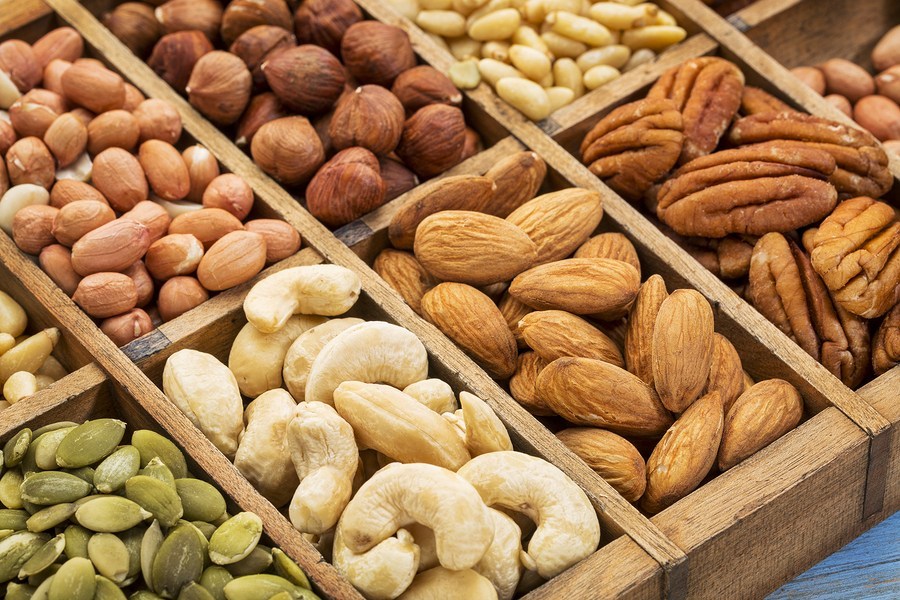Nuts are healthy snack options.
Though they’re usually high in fat, the fat they contain is a healthy type. They’re also good sources of fiber and protein.
Many studies have shown that nuts provide various health benefits — especially in regards to reducing heart disease risk factors.
Here are 9 impressive nuts and their health benefits.
Health Benefits of Eating Nuts
In general, nuts are good sources of fat, fiber and protein.
Most of the fat in nuts is monounsaturated fat, as well as omega-6 and omega-3 polyunsaturated fat. However, they do contain some saturated fat.
Nuts also pack a number of vitamins and minerals, including magnesium and vitamin E.
Many studies have investigated the health benefits of increased nut intake.
One meta-analysis of 33 studies found that diets high in nuts do not significantly affect weight gain or weight loss (1Trusted Source).
Yet, despite having little effect on weight, many studies have shown that people who eat nuts live longer than those who don’t. This may be due to their ability to help prevent a number of chronic diseases (2Trusted Source, 3Trusted Source, 4Trusted Source, 5Trusted Source).
For example, nuts may reduce risk factors for metabolic syndrome, such as high blood pressure and cholesterol levels (6Trusted Source, 7Trusted Source, 8Trusted Source, 9Trusted Source).
In fact, one study in over 1,200 people found that eating a Mediterranean diet plus 30 grams of nuts per day decreased the prevalence of metabolic syndrome more than a low-fat diet or a Mediterranean diet with olive oil (10Trusted Source).
Furthermore, nuts may reduce your risk of other chronic diseases. For example, eating nuts may improve blood sugar levels and lower your risk of certain cancers (11Trusted Source, 12Trusted Source).
SUMMARY
Eating nuts may help reduce risk factors for many chronic diseases, including heart disease and diabetes.
1. Almonds
Almonds are tree nuts that contain a number of beneficial nutrients (13).
One serving — 28 grams or a small handful — packs roughly:
- Calories: 161
- Fat: 14 grams
- Protein: 6 grams
- Carbs: 6 grams
- Fiber: 3.5 grams
- Vitamin E: 37% of the Reference Daily Intake (RDI)
- Magnesium: 19% of the RDI
Almonds may improve cholesterol levels.
A number of small studies have found that eating an almond-rich diet can reduce “bad” LDL cholesterol, total cholesterol and oxidized LDL cholesterol, which is particularly harmful to heart health (14Trusted Source, 15Trusted Source, 16Trusted Source).
However, one larger study combined the results of five other studies and concluded that the evidence is insufficient to suggest that almonds undoubtedly improve cholesterol (17Trusted Source).
Nevertheless, almonds consumed as part of a low-calorie diet may aid weight loss and lower blood pressure in people who are overweight or obese (18Trusted Source, 19Trusted Source).
In addition, eating a meal with one ounce (28 grams) of almonds may help lower the rise in blood sugar that happens after a meal by as much as 30% in people with diabetes but not significantly in healthy people (20Trusted Source).
Moreover, almonds have been shown to reduce inflammation in people with type 2 diabetes (21Trusted Source).
Finally, almonds may have a beneficial effect on your gut microbiota by supporting the growth of beneficial gut bacteria, including Bifidobacteria and Lactobacillus (22Trusted Source).
SUMMARY
Almonds contain a number of important nutrients that may help reduce heart disease and diabetes risk factors. However, larger studies are needed to confirm these effects.
2. Pistachios
Pistachios are a commonly consumed nut that is high in fiber (23).
A one-ounce (28-gram) serving of pistachios contains roughly:
- Calories: 156
- Fat: 12.5 grams
- Protein: 6 grams
- Carbs: 8 grams
- Fiber: 3 grams
- Vitamin E: 3% of the RDI
- Magnesium: 8% of the RDI
Similarly to almonds, pistachios may improve cholesterol levels — eating 2–3 ounces (56–84 grams) of pistachios a day may help increase “good” HDL cholesterol (24Trusted Source).
Also, pistachios may help improve other heart disease risk factors, including blood pressure, weight and oxidative status.
Oxidative status refers to blood levels of oxidized chemicals, which can contribute to heart disease (25Trusted Source, 26Trusted Source, 27Trusted Source, 28Trusted Source).
What’s more, pistachios may help reduce the rise in blood sugar after a meal (29Trusted Source).
SUMMARY
Pistachio nuts appear to have beneficial effects on heart disease risk factors when eaten in high quantities of more than one ounce (28 grams) per day.
3. Walnuts
Walnuts are a very popular nut and an excellent source of the omega-3 fatty acid alpha-linolenic acid (ALA) (30).
A one-ounce (28-gram) serving of walnuts contains roughly:
- Calories: 182
- Fat: 18 grams
- Protein: 4 grams
- Carbs: 4 grams
- Fiber: 2 grams
- Vitamin E: 1% of the RDI
- Magnesium: 11% of the RDI
Walnuts appear to improve a number of heart disease risk factors, which may be due to their high content of ALA and other nutrients.
Several large studies have found that eating walnuts significantly reduced total cholesterol and “bad” LDL cholesterol while increasing “good” HDL cholesterol levels (31Trusted Source, 32Trusted Source, 33Trusted Source).
They may also improve other factors related to heart health, including blood pressure and the normal flow of blood through your circulatory system (34Trusted Source, 35Trusted Source).
In addition, walnuts may help reduce inflammation, which can contribute to many chronic diseases (36Trusted Source).
Interestingly, a study in college students found that eating walnuts increased a measure of cognition called “inferential reasoning,” suggesting that walnuts may have beneficial effects on the brain (37Trusted Source).
SUMMARY
Walnuts are a great source of the omega-3 fat ALA and many other nutrients. Eating walnuts may benefit heart health and potentially even your brain.
4. Cashews
Cashews are part of the tree nut family and have a good nutrient profile (38).
One ounce (28 grams) of cashews contains roughly:
- Calories: 155
- Fat: 12 grams
- Protein: 5 grams
- Carbs: 9 grams
- Fiber: 1 gram
- Vitamin E: 1% of the RDI
- Magnesium: 20% of the RDI
A number of studies have examined whether diets high in cashews can improve symptoms of metabolic syndrome.
One study found that a diet containing 20% of calories from cashews improved blood pressure in people with metabolic syndrome (39Trusted Source).
Another study noticed that cashews increased the antioxidant potential of the diet (40Trusted Source).
Interestingly, a few studies have shown that diets high in cashews may increase blood sugar in people with metabolic syndrome (39Trusted Source, 41Trusted Source).
Another larger study observed that a diet rich in cashews reduced blood pressure and increased levels of “good” HDL cholesterol. However, it had no significant effects on body weight or blood sugar levels (42Trusted Source).
SUMMARY
Cashews contain a number of important nutrients and studies indicate that they may improve blood lipid levels and reduce blood pressure.
5. Pecans
Pecans are often used in desserts, but they’re quite nutritious on their own (43).
One ounce (28 grams) of pecans contains roughly:
- Calories: 193
- Fat: 20 grams
- Protein: 3 grams
- Carbs: 4 grams
- Fiber: 2.5 grams
- Vitamin E: 2% of the RDI
- Magnesium: 8% of the RDI
A few studies have shown that pecans can lower “bad” LDL cholesterol in people with normal cholesterol levels (44Trusted Source, 45).
Like other nuts, pecans also contain polyphenols, which are compounds that act as antioxidants.
In one four-week study, people who ate pecans as 20% of their daily calorie intake showed improved antioxidant profiles in their blood (46).
SUMMARY
Pecans contain a variety of beneficial nutrients. They also pack antioxidants and may help lower “bad” LDL cholesterol.
6. Macadamia Nuts
Macadamia nuts contain a wide range of nutrients and are a great source of monounsaturated fat (47).
One ounce (28 grams) contains roughly:
- Calories: 200
- Fat: 21 grams
- Protein: 2 grams
- Carbs: 4 grams
- Fiber: 2.5 grams
- Vitamin E: 1% of the RDI
- Magnesium: 9% of the RDI
Many of the health benefits of macadamia nuts are related to heart health. This may be due to their high content of monounsaturated fat.
A number of studies have shown that diets rich in macadamia nuts can lower both total cholesterol and “bad” LDL cholesterol in those with high cholesterol levels (48Trusted Source).
A macadamia-rich diet even produced effects similar to a heart-healthy diet recommended by the American Heart Association (49Trusted Source).
In addition, macadamia nuts may reduce other risk factors for heart disease, including oxidative stress and inflammation (50Trusted Source).
SUMMARY
Macadamia nuts are very high in monounsaturated fat. This may explain their ability to reduce heart disease risk factors.
7. Brazil Nuts
Brazil nuts originate from a tree in the Amazon and are an incredibly rich source of selenium (51).
A one-ounce (28-gram) serving of Brazil nuts contains about:
- Calories: 182
- Fat: 18 grams
- Protein: 4 grams
- Carbs: 3 grams
- Fiber: 2 grams
- Vitamin E: 8% of the RDI
- Magnesium: 26% of the RDI
Selenium is a mineral that acts as an antioxidant. Though it’s used for a number of bodily functions, you only need to obtain small amounts of it through your diet.
A one-ounce (28-gram) serving of Brazil nuts will provide you with more than 100% of the RDI for selenium.
Selenium deficiency is rare and usually only occurs in certain disease states.
For example, one study found that people undergoing hemodialysis for kidney disease were selenium deficient.
When these people ate just one Brazil nut a day for three months, their blood selenium levels returned to normal, and the nuts had an antioxidant effect in their blood (52Trusted Source).
Brazil nuts can also reduce cholesterol levels. What’s more, they may reduce oxidative stress and improve the function of blood vessels in obese teenagers (53Trusted Source, 54Trusted Source).
Finally, Brazil nuts may reduce inflammation in both healthy people and those undergoing hemodialysis (55Trusted Source, 56Trusted Source).
SUMMARY
Brazil nuts are an excellent source of selenium. They may also help reduce cholesterol levels, oxidative stress and inflammation.
8. Hazelnuts
Hazelnuts are very nutritious (57).
One ounce (28 grams) of hazelnuts contains roughly:
- Calories: 176
- Fat: 9 grams
- Protein: 6 grams
- Carbs: 6 grams
- Fiber: 3.5 grams
- Vitamin E: 37% of the RDI
- Magnesium: 20% of the RDI
Like many other nuts, hazelnuts appear to have beneficial effects on heart disease risk factors.
One study found that a hazelnut-rich diet reduced total cholesterol, “bad” LDL cholesterol and triglycerides. It also lowered markers of inflammation and improved blood vessel function (58Trusted Source).
Other studies have shown that hazelnut diets can improve cholesterol levels and increase the amount of vitamin E in the blood (59Trusted Source, 60Trusted Source).
SUMMARY
Hazelnuts are a good source of many nutrients, such as vitamin E. They may also reduce heart disease risk factors.
9. Peanuts
Unlike the other nuts in this article, peanuts are not tree nuts, but belong to the legume family.
However, they have similar nutrient profiles and health benefits as tree nuts (61).
One ounce (28 grams) of dry-roasted peanuts contains roughly:
- Calories: 176
- Fat: 17 grams
- Protein: 4 grams
- Carbs: 5 grams
- Fiber: 3 grams
- Vitamin E: 21% of the RDI
- Magnesium: 11% of the RDI
A study in over 120,000 people found that higher peanut intake was associated with lower death rates (2Trusted Source).
Peanuts may also improve heart disease risk factors(62Trusted Source).
Interestingly, one study found that women who ate peanut butter more than five times a week had lower rates of type 2 diabetes (63Trusted Source).
Furthermore, asthma and allergic disease rates may be lower in children of mothers who ate peanuts once or more per week during pregnancy (64Trusted Source).
However, many brands contain large amounts of added oils, sugar and other ingredients. Therefore, it’s best to choose peanut butter with the highest peanut content.
Similarly, peanuts are usually salted, which may eliminate some of their associated health benefits. Instead, try to choose plain, unsalted, unflavored peanuts.
SUMMARY
Unlike most other nuts, peanuts belong to the legume family. However, they have nutrient profiles that are similar to tree nuts and may also help reduce risk factors for heart disease and diabetes.
The Bottom Line
Nuts are one of the healthiest snacks you can eat, as they contain a wide range of essential nutrients.
However, their beneficial effects are attributed to nuts that have been minimally processed and have no added ingredients.
Many processed nut products, such as peanut butter, often contain high amounts of salt or added sugar. As a result, it’s best to buy nuts with nothing else added.
When incorporated into a healthy diet consisting of other natural, whole foods, nuts may help reduce risk factors for many chronic diseases.





